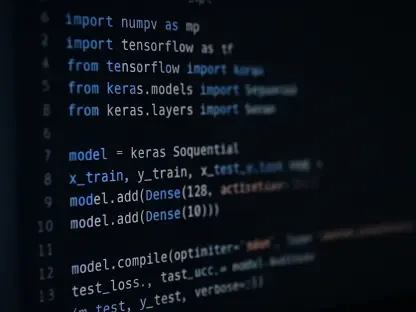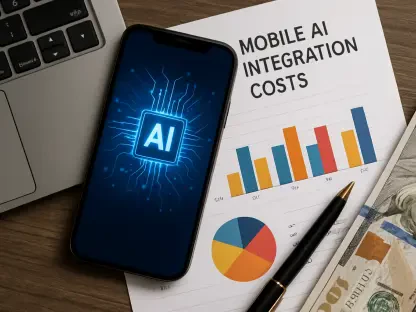Artificial intelligence (AI) and machine learning (ML) are catalysts transforming software development. With insights drawn from a survey of over 800 developers (DevOps) and application security (SecOps) professionals, this article unravels the overarching trends, benefits, challenges, and the future landscape shaped by AI. Through its integration into workflows, AI enhances code generation, testing, and analysis, propelling software development into a new era of efficiency and innovation.
The Integration of AI in Development Workflows
Enhancing Code Generation and Testing
AI tools have become crucial in automating various tasks, making software development more efficient and accurate. A striking 97% of professionals reported using generative AI in their workflows, which has substantially reduced development cycles and errors. Tools like GitHub’s Copilot, powered by Codex, exemplify this trend by offering timely support in code generation. This capability not only accelerates coding processes but also elevates the quality of the output, saving developers crucial hours that can be spent on more complex and innovative tasks.
The widespread adoption of these AI tools underscores their growing utility. According to the survey, 86% of developers use ChatGPT, and 70% leverage GitHub Copilot. This shift indicates that AI adoption has become fundamental even in routine coding tasks. The idea that “the hottest new programming language is English” captures the essence of this transformation, as these tools allow developers to program through natural language commands. Such progression suggests a future where developers are primarily engaged in higher-order thinking and problem-solving, leaving the mundane and error-prone aspects to AI.
Adding Value Across Skill Levels
For senior developers, AI tools are a game-changer that frees them from mundane, repetitive coding tasks, thereby enabling them to focus on resolving more complex issues and optimizing overall productivity. These developers can now allocate more time to designing sophisticated systems, mentoring junior colleagues, and making strategic architectural decisions. The automation of routine tasks by AI essentially amplifies the senior developers’ ability to contribute to more critical aspects of the project, driving general advancements.
Junior developers, on the other hand, benefit immensely from AI-based mentorship. These tools can quickly address their questions and help them comprehend technical jargon without placing a heavy reliance on senior team members. This accessibility to instant, reliable answers aids in their rapid learning and skill development. AI tools like GitHub Copilot Chat further streamline workflows by facilitating repository-level queries. This feature significantly accelerates the onboarding process for new projects, reducing the learning curve associated with legacy or unfamiliar codebases and enabling faster integration into ongoing work. Consequently, junior developers can become productive team members more rapidly, with AI acting as both mentor and collaborator.
Security Implications and Concerns
Navigating Security Challenges
Despite their undeniable efficiency, AI tools present notable security challenges that need to be meticulously managed. A significant number of DevOps professionals have expressed concerns about vulnerabilities, particularly those arising from the use of open-source code. This anxiety stems from the fact that while open-source resources are invaluable, they can sometimes introduce unforeseen weak spots that malicious actors might exploit. Therefore, a balanced approach is essential for enterprises to harness the power of AI while mitigating associated risks.
Enterprises must remain vigilant to prevent security breaches and ensure compliance with licensing terms. Robust security measures, including regular audits and continuous monitoring, are imperative to safeguard against potential threats. Furthermore, integrating advanced security protocols can help in identifying and addressing vulnerabilities more effectively. The responsibility also extends to developers, who need to be trained in best security practices when using AI tools. This multi-faceted approach ensures that while the benefits of AI are maximized, the potential pitfalls are effectively circumvented.
Ensuring Correctness and Mitigating Bias
Effective oversight is crucial to ensure the correctness of AI outputs and to mitigate any inherent biases that might be present in the models. Large Language Models (LLMs) can sometimes generate false or biased information, necessitating human intervention to rectify these inaccuracies. The maintenance of high software integrity is paramount, and this requires continuous evaluation and adjustment of the AI tools in use. Developers and security professionals must work collaboratively to monitor AI outputs and ensure they meet the established standards of accuracy and fairness.
Addressing these concerns is essential to mitigate risks like technical debt and to maintain the reliability of the software being developed. Technical debt can accumulate quickly if AI-generated code is not properly vetted, leading to long-term issues that could compromise the software’s functionality and security. Additionally, bias in AI outputs can result in unfair or unethical outcomes, particularly in applications that impact decision-making processes. Therefore, implementing checks and balances, such as diverse data sets and bias detection algorithms, is necessary to uphold the ethical standards and robustness of AI in software development.
Impact on Job Roles and Responsibilities
Role Shifts Rather Than Job Displacement
The integration of AI in software development raises concerns about job displacement, a topic that has fueled much debate. However, the prevailing trend points more towards a shift in roles rather than outright job elimination. AI’s capability to handle routine and repetitive tasks allows human developers to invest their time and expertise in more creative and strategic endeavors. This transformation underscores the growing value of human creativity and strategic decision-making in the development process, rather than diminishing the need for human involvement.
As machines take over more standardized tasks, developers are presented with opportunities to focus on higher-level functions that require critical thinking and innovation. This shift not only enhances job satisfaction but also promotes a more dynamic and forward-thinking work culture. The roles of developers are evolving to include strategic planning, system architecture, and complex problem-solving, areas where human ingenuity and experience are irreplaceable. This evolution signifies a collaborative future where AI and humans work hand in hand to push the boundaries of what is possible in software development.
Enhancing Collaboration and Learning
AI acts as a facilitator for enhanced collaboration between senior and junior developers, fostering a work environment that is both efficient and educational. By automating routine tasks and providing immediate, reliable answers to junior developers, AI creates a more streamlined and productive workflow. This, in turn, allows senior developers to concentrate on more complex challenges and mentorship activities. The immediate feedback and guidance from AI tools help junior developers learn and adapt quickly, cultivating a culture of continuous learning and growth within the organization.
This collaborative approach aids in cultivating a workplace where knowledge sharing and mentorship are integral to the development process. AI tools can bridge knowledge gaps by offering tailored assistance to junior developers, ensuring they understand the intricacies of coding principles and practices. As a result, the entire team benefits from a well-rounded and knowledgeable workforce. Furthermore, the use of AI in collaboration fosters a symbiotic relationship between technology and human developers, where each complements the other’s strengths, leading to more innovative and effective software development solutions.
Adoption of AI and ML Tools in Enterprises
Enterprise-Wide Acceptance
The adoption of AI and ML components within corporate environments has seen a notable increase, reflecting a growing understanding of their potential to revolutionize workflows and decision-making processes. Over the past year, the incorporation of these technologies has doubled, signifying a broader acceptance and recognition of their transformative capabilities. Enterprises are increasingly utilizing frameworks such as scikit-learn, PyTorch, and HuggingFace transformers, which are gaining prominence and becoming essential components of their technological stacks.
This trend highlights the diverse ecosystem of AI tools available to organizations, offering a range of solutions tailored to different needs and applications. The movement towards integrating AI and ML into enterprise operations demonstrates a commitment to leveraging advanced technologies to drive efficiency and innovation. By adopting these tools, companies can automate repetitive tasks, enhance data analysis, and make more informed decisions, ultimately leading to improved productivity and competitive advantage. The continuous expansion and adoption of AI and ML within enterprises underscore the evolving landscape of technology in the corporate world, paving the way for more intelligent and adaptive business processes.
Benefits and Challenges of LLM-as-a-Service
LLMs-as-a-service offer significant advantages such as accelerated development cycles and high performance, primarily because they leverage server-side processing power. This capability enables developers to integrate advanced language understanding and generation capabilities into their applications through simple API calls. The result is a streamlined development process where complex language tasks are handled efficiently by the AI, allowing developers to focus on other critical aspects of application development. This has led to a surge in the adoption of LLM-as-a-service solutions by enterprises looking to enhance their AI capabilities without the need for extensive in-house resources.
However, along with these benefits come several challenges that organizations must navigate carefully. Cost is a primary concern, as the usage of these services can become expensive as token consumption increases. Additionally, data privacy and security are significant issues, given that sensitive information may be processed by third-party servers. The risk of vendor lock-in is another critical consideration, as reliance on a specific service provider can make an organization vulnerable to potential disruptions or changes in the service. Balancing these benefits and challenges is crucial for organizations aiming to integrate LLMs effectively into their workflows, ensuring they maximize the potential while mitigating associated risks.
Managing Licensing and Security Risks
Navigating Model Selection
Data scientists face the intricate challenge of choosing from an extensive repository of over 337,000 models to find the right fit for their applications. This decision-making process involves selecting the appropriate version, parameter size, embeddings, and context window to optimize performance and achieve desired outcomes. The vast array of options requires careful consideration and evaluation to ensure the chosen model aligns with the specific needs and goals of the project. Additionally, understanding the intricacies of each model and its capabilities is essential for making informed choices that will drive the success of the application.
The complexity of navigating model selection underscores the importance of expertise and experience in the field of data science. Data scientists must possess a deep understanding of machine learning principles, coupled with practical knowledge of different models and their applications. This expertise enables them to make strategic decisions that enhance the performance and efficiency of the AI systems they develop. As the landscape of AI models continues to evolve, staying updated with the latest advancements and methodologies becomes crucial for data scientists aiming to leverage the best models for their projects.
Addressing Licensing and Security Issues
Ensuring compliance with licensing terms is vital to avoid legal liabilities and potential copyright infringement issues. Many AI models train on publicly available data without obtaining proper permissions from copyright holders, which can lead to significant legal conflicts. It is imperative for teams to practice due diligence by thoroughly understanding and adhering to the licensing terms of both foundational and derived models. This transparency and adherence to legal standards are essential to ensure ethical and lawful deployment of AI technologies.
Furthermore, security concerns revolve around the potential for uncensored or inflammatory responses from models, as well as their susceptibility to jailbreaking. Implementing robust security measures and continuous monitoring is essential to mitigate these risks and ensure the safe and reliable operation of AI systems. Teams must also focus on building secure and transparent practices to protect sensitive data and maintain the integrity of their AI applications. By addressing these licensing and security issues proactively, organizations can safeguard their AI initiatives and foster a trustworthy and compliant environment for innovation.
Evolving AI Tools Landscape
Growth of Open Source and Proprietary Models
The ecosystem of LLMs is expanding rapidly, with significant contributions from both tech giants and open-source communities. This growth reflects a collaborative effort to advance AI technologies and make them more accessible and secure. Companies are increasingly adopting open-source AI components, emphasizing the importance of transparency and community-driven improvements. Tools like Safetensors and CUDA GPU accelerators are gaining traction, offering enhanced security and efficiency in AI applications. This shift towards open-source solutions underscores a commitment to fostering innovation and collaboration within the AI community.
The adoption of open-source and proprietary models highlights the diverse range of options available to organizations, allowing them to choose solutions that best fit their specific needs and goals. This flexibility enables companies to leverage cutting-edge technologies while maintaining control over their AI systems. The ongoing development and improvement of these models by both commercial entities and open-source contributors ensure a continuous evolution of the AI landscape, driving progress and enabling more sophisticated and effective applications.
Promoting Transparency and Accountability
Artificial intelligence (AI) and machine learning (ML) are revolutionizing software development. These technologies serve as catalysts that reshape how code is generated, tested, and analyzed. Drawing insights from a survey of over 800 developers, including professionals in DevOps and SecOps, this article delves into the major trends, benefits, and challenges posed by AI in software development, as well as what the future holds.
AI’s integration into workflows is proving to be a game-changer. By automating routine tasks and providing intelligent insights, AI is significantly enhancing efficiency and sparking innovation. It enables developers to produce higher-quality code at a faster pace, leading to more robust and secure applications.
However, the road to fully integrating AI into software development is not without its hurdles. One of the primary challenges is the need for more training and skill development among developers to effectively utilize AI tools. There’s also the question of how to manage and maintain these sophisticated systems to ensure they deliver consistent and reliable results.
Looking ahead, the influence of AI and ML in software development is only expected to grow. As these technologies continue to evolve, they promise to unlock new levels of productivity and creativity, paving the way for a future where software development is more intuitive, responsive, and efficient than ever before.









